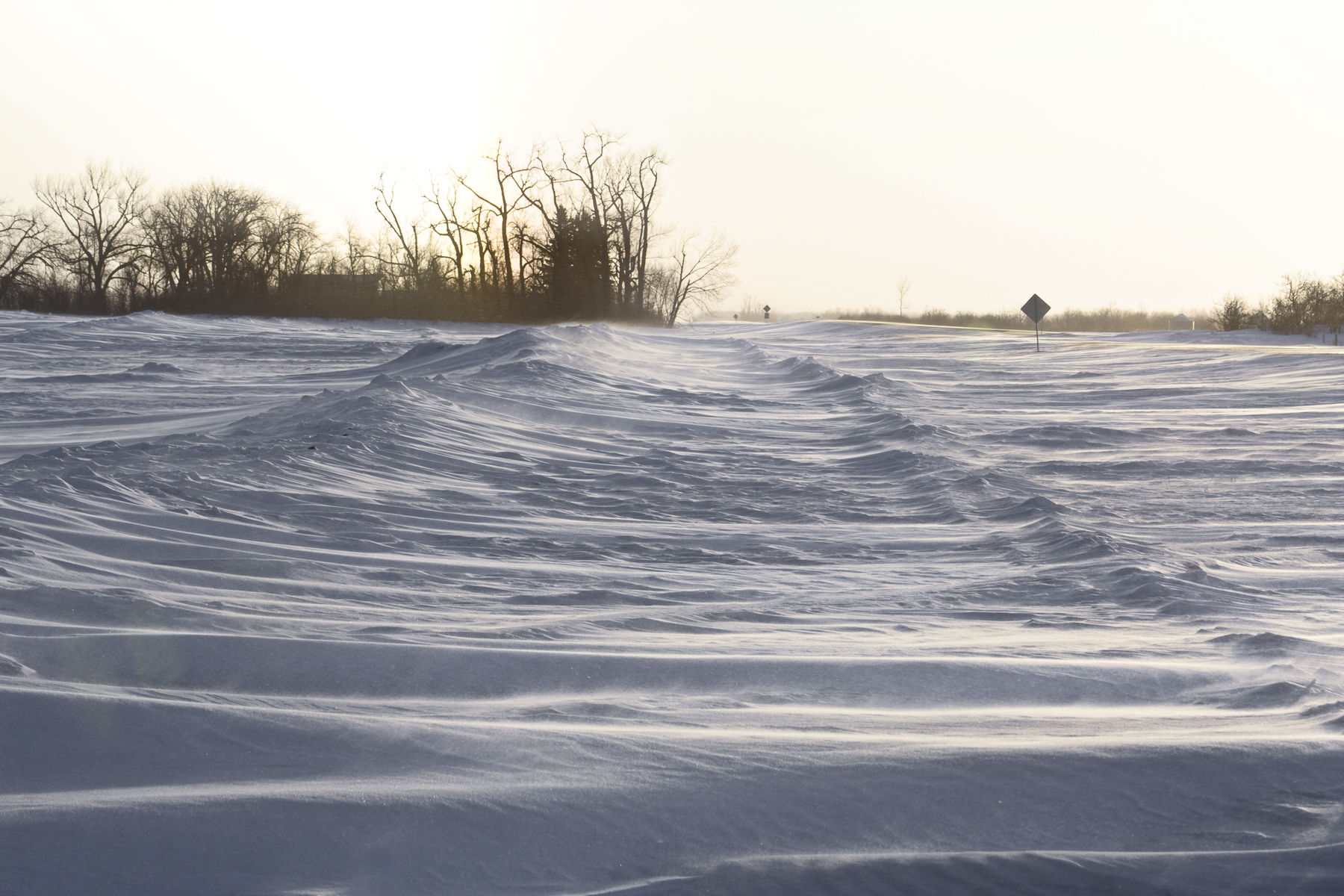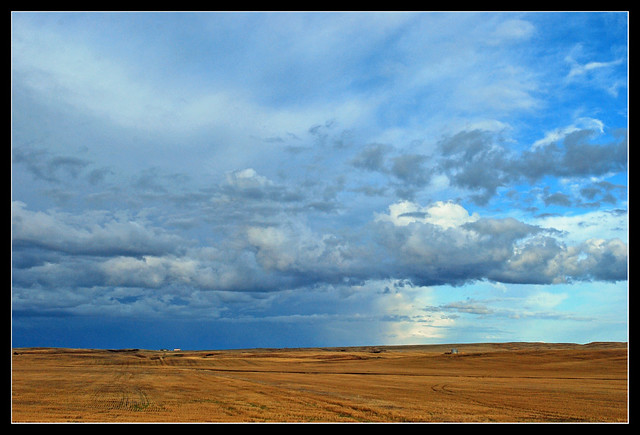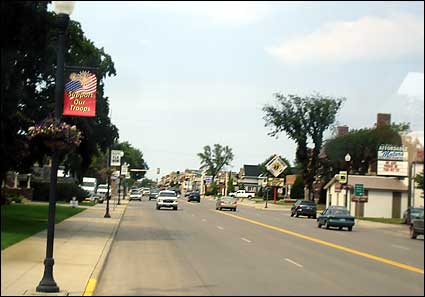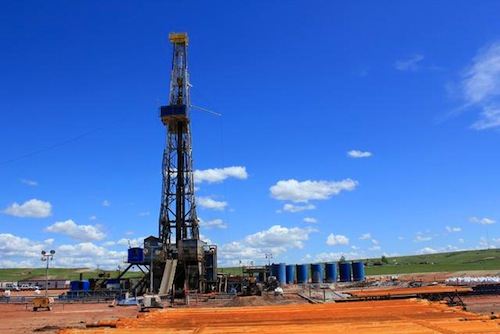Note to all you folks thinking of moving to North Dakota to start cashing in on the oil boom: North Dakota is cold.

There aren’t a lot of trees. And outside of the eight or nine significant-sized cities (Fargo, Grand Forks, Jamestown, Devil’s Lake, Bismark/Mandan, Minot, Williston, Dickinson, and maybe Valley City), there just aren’t a whole lot of people.
More below the jump, so the rest of the page can load…
But you know the stereotypes.

What the place lacks in trees and people, it makes up for in wind, and windy cold in the winter, and windy dry heat in the summer, and a horizon that’s far enough away to give an agoraphobiac a seizure. And above it all, a sky that a schoolgirl – a young African-American girl whose parents were stationed at Minot Air Force Base – once referred to as “big and blue and full of the mind of God” to an observer.

We’ll come back to that quote, and the observer, in a bit.
As NPR, and MPR, and the New York Times tell us (and tell us, and tell us), the oil boom is not an unalloyed blessing to everyone. Breitbart, in a story about the increase in oil production in the state, embedded this video, from Time magazine, about three transplants (one from the Iron Range) who are having their misgivings about living in the boom. The guys – a roughneck and a trucker – are bored with man camps and having nothing to do but working, drink, watch TV and play video games. The woman – a gofer – misses people and free time and an outside world.
The video clocks at about 13 minutes, and is worth a watch.
All three of the subjects of the video – shot amid what could easily be stock “North Dakota B-Roll” footage of drifting snow and howling winds – bemoan the loneliness, the isolation, the lack of…stuff. Things. Distractions. Background chatter.

And if you watch the video – or lots of the news coverage of the people moving to North Dakota for the oil boom – you’d almost think you were watching a story on Mars colonists, people who are going where nobody’s gone before.
It’s wrong, of course – but for most of the country, it’s probably not a bad simile.
———-
On the one hand, I feel for them. I grew up there. Not out on the Bakken, of course; I was a city boy in Jamestown (pop. 15,000), in the eastern third of the state, then and now safely hidden away from any hint of excessive, unseemly prosperity (maybe), but with people around, down in a valley that deflected the endless wind and brought the horizon in close around me for most of my early years.

Main street in Jamestown. By central ND standards, it’s an urban jungle. I actually met people in little towns like Bordulac (pop ~50) who didn’t like coming to Jamestown because of the traffic and crime. My dad still lives about a block from where this shot was taken.
On the other hand? People live there. They raise families, they have careers and homes andlives, just like anyone in Portland or Grand Rapids or New York…
…but different, too.
The schoolgirl’s observation about the North Dakota sky (“big and blue and full of the mind of God”) comes from a 20-year-old book, Dakota – A Spiritual Geography by Kathleen Norris. And if you know anyone who’s thinking about moving out to NoDak to cash in on the oil boom, you could do a lot worse than having them read the book.
In 1974, Norris and her husband were hangers-on in the New York literary scene; they worked for literary mags, they wrote poetry, they went to brie-and-chablis receptions in TriBeCa – all of the code terms for “thoroughly urban and utterly urbane”.
And then Norris got a letter from an attorney in Lemmon, South Dakota; her grandmother, who owned a farm nearby, had passed away, and willed the farm to Norris and her husband.
The couple went west, thinking it’d be a fun lark; hang out on the farm for a bit, then sell it and return to the city with some funny farm stories. Like Green Acres for cool people.
It didn’t pan out, of course; the Norrises became attached to the place.
But – as Dakota reminds us – not in an uncritical way. There is much to love about life on the drift prairie; if you’re an outdoorsman, there’s a lot of outdoors. People are honest, prices low and crime virtually nonexistant (outside the oilfields with their shortages and bored outsiders), and some of the modern world’s more pointless and frenetic changes get filtered out before they make it out there. And it’s a beautiful place – in a very simple, raw way. And while the environment is raw and merciless, a professor of mine – a Philadelphia transplant who still lives in Jamestown, 30 years later – pointed out that people in the northern Plains who do appreciate things like art, music, culture and other things that transcend the here and now, appreciate them a lot more than people who are surrended by them all the time, and often practice them with a zeal that astounds him; small-town art galleries, recitals, plays and concerts are a big event; authors, playwrites and musicians crank away on labors of love that may be obscure outside the region, but are vital in the local here and the regional now.
But the challenges and tribulations are simple and raw, too. Mother Nature is a cast-iron bitch out there; brutal cold, wilting heat, furious storms, and above all the wind. It never stops. There are stories – I remember them, and Norris writes about them – of farmhouses discovered with doors open, breakfast sitting on the table, but no farmers or families; the wind drove them over the edge; they packed up and left without a forwarding address. They had to go somewhere else (one hopes) – to get away from the damned eternal wind. And it’s been worse, you are (or were) reminded; in the seventies and eighties, the Dust Bowl was still in peoples’ living memory.
Between the weather, the sparse population and the distances between human habitation, each little settlement is like an island – an island surrounded by grass and furrows and alfalfa or wheat or sunflowers instead of water, but very nearly as isolated. There just aren’t a lot of distractions. Even today, with the internet and hundreds of channels of cable, it’s an isolated place.
And Norris’ biggest observations were about the people who live there, and had for most of a century, through bonanza and dustbowl and boom and bust.

Norris compared the locals – the people who survive and thrive in such a hostile place – to monks; people who’ve taken vows of simplicity and self-abnegation, who mix a sunny “Can Do” attitude to fixing up and brightening their surroundings with a monastic aesceticism that accepts a life with a level of ambient hardship and self-denial.
It’s not entirely a noble thing; generations of self-denial led to a culture that doesn’t expect much, is expected to be satisifed with what it’s got and not to ask for a whole lot more, and gets a little passive-aggressive about those who do. The Norwegian idea of Janteloven — knowing your place and not getting uppity – is alive and well (or at least it was when I was a kid).
Norris’ observations were a watershed to me when I first read it, back in the nineties. It helped me understand some of the “fish out of water” aspects of my own personality after almost a decade in the big city, and some of the things I was missing about the place – and a few that I really, really didn’t.
Scranton, ND’s entertainment district
The three subjects of the video brought back both sides of the coin for me. “Quit your blubbering; you came here looking for a way to make ends meet, and you found it in spades. And STFU; people live here, and were living here long before TV and video games. So quit crying to me about how bored you are; I survived. You might, too”, says the homer.
The guy who left the place feels for ’em, too. That guy wants to give the three of them – and other newbies to the area – a couple pieces of advice:
- There is no such thing as cold weather. Only inadequate clothing.
- “Boredom” is a state of mind. Step outside the box to keep it occupied, whatever “outside the box” means to you; read a book, become a poker master, learn the drums, get addicted to Fantasy Football…whatever. Maybe all of the above. Boredom is a 100% preventable disease. God knows I had plenty of practice in my day – and I lived there 22 years.
- As to the locals? They were hard to get to know even before the place became overrun with outsiders. But it wouldn’t hurt at all to try, in your spare time.
Anyway – if you know someone who’s thinking about making the move, you could worse than give them a copy of Dakota.
Forewarned is forearmed.

Beautiful, Mitch . . .
We were driving through the Brakken and other parts of nowhere last month when my son announced, “This would the place to be in the Zombie Apocalypse!” I asked why he thought so and he said, “There’s nobody here so no zombies, and even if there is one you could see it in the morning and not have to worry about it until after dinner.”
ND is a truly beautiful place, it could be considered a sportmans paradise, fishing, hunting, skiing, snowmobiling, on and on. I’ve spent many a day there, part of our company is located in Mandan. A very good friend is from Washburn and located here before the oil boom, he misses home and it wouldn’t surprise me if he moves back to friends and family. His craft skills are in much demand there and he’d make a very good wage, that just wasn’t the case before oil.
I remember seeing a stand-up comedienne – whose name I don’t remember – talking about her ancestors and how they came to ND from Norway. Crossing oceans, and mountains, and rivers, and deserts, to find the one place in the world that was just as fucking miserable as the place they’d left.
They buried nukes up there for a reason.
I think that I’ve shared this story before, but when I first got to Grand Forks AFB, I had to go to orientation. The old Chief Master Sergeant that gave the briefing quipped that they didn’t worry about us going AWOL for three weeks because they could still see us running. They also showed us what to pack in our auto survival kits and issued everyone a winter parka, bunny boots if you worked outside and arctic mittens. They advised us that we were to have the kit, parka and mittens with us anytime we left the base from November 1 to May 1. The guards at the gates always checked, too. If you didn’t have them with you, they had no sense of humor about it and made you go back and get them. Apparently, a few airmen froze to death when they ran off Highway 2 during blizzards, because they didn’t have them.
You are so right about the wind, Mitch! Being a native, you probably know that Highway 2 is slightly elevated with deep ditches between and on each side, to allow the wind to blow the snow off of it and reduce the need for plows.
Swiftee, the during the 1970’s, the Air Force bragged that if North Dakota was a separate world power, it would have been the third largest in the world, due to all of the B-52s and missiles stationed there.
Everything I’ve read here leads me to suppose that NoDakans (whether native or adopted) would be particularly well suited for Martian colonization…
When one of the top Air Force commanders came to Minot 2.5 or so years ago, he had couldn’t get out due to the snow. So the AF ran a snow plow ahead of a car from the base north of Minot, to the Amtrak depot. He was able to take a train to St Paul when all roads and air ports were closed.
I have vacationed in Minot around January 20th three different years to do some winter photographery. There is something about that area during peak winter weather. I know an amature (but very good) photographer whose nitch is rural NW Minnesota and North Dakota churches in winter. Think white wooden church with a steeple, framed by very frosty trees.
Boss, Minot is one of only two places in the world with active duty B-52s. People in blue states complain about tax dollars being spent in red states, but I bet chicago would be happy if their city was saved from a Soviet attack due to air bases in Grand Forks and Minot.
Bosshoss, I’ve got a buddy that was at Grand Forks about the time you were. Does the name “Robert (Bob) Janette” ring a bell?
Chuck; Yea, I knew that the B-52s that were there went to Barksdale AFB in Louisiana. There were B1s there for awhile, but I don’t think that there are any bombers there anymore.
Powhatan; Actually, the name sounds familiar. Was he involved in aircraft support in some way? There were a lot of specialty maintenance groups, i.e. avionics, electricians, munitions, jet engine shop, corrosion control (paint shop), etc.
Very nice.
And yes, it is the wind that kills you, not the cold. If you’re dressed right, 0 degrees with absolutely no wind can be invigorating, even comfortable if you’re moving.
I’ve always said I’d rather be cold than hot. You can always put on clothes till you reach equilibrium. If you’re hot, you can’t just keep removing clothes. You’ll reach inappropriate before you reach equilibrium.
Bosshoss-
I think Bob was an avionics guy. He stayed in the guard after after his regular enlistment was up, and now works for whatever is left of Medtronic.
Powhatan;
Then yes, I probably ran into him a time or two. I was actually associating the name with one of those specialties. As a Crew Chief, I was in an Organizational Maintenance Squadron (OMS) which essentially means that we knew a little bit about everything, but a lot about nothing. We referred to ourselves as ramp rats and did the mundane crap, including making sure that things that broke, got fixed. My signature on the maintenance records, certified that the plane was ready to fly. It was always double checked by the Line Chief and the Maintenance Officer. Pretty big responsibilities for a 19 year old kid that wasn’t old enough to drink in North Dakota.
I hesitate to comment on this because I have the sense I’m alone in my experience here and not up to the task of explaining why that matters.
I graduated college during Carter’s malaise. There were no jobs for liberal arts majors. A buddy and I rented the basement of a little old lady’s house in Dickinson and commuted half-an-hour each way to work in Killdeer. We drove Kenworth trucks 12-hour shifts in the Badlands: he, picking up oil from wellhead storage tanks to deliver to the pipeline in Williston (same as one of the guys in the movie); I, delivering fresh water to drilling rigs for the slurry.
That kid is a roustabout working for a driller, the head man on a drilling rig. I met a lot of people like him, working a lot of hours doing dirty, exhausting work, but never as big a bunch of whiners as I saw on that film. A young kid with no education or experience makes $93,000 and isn’t satisfied? A woman travels halfway across the country to work a job she hates but can’t find any other job anywhere else in the entire nation? Makes me think of the scene in Ghostbusters where Bill Murray tells the secretary to go work in food service or housekeeping, if she doesn’t like her job.
Out of 30,000 oilfield workers you couldn’t find one person who was grateful to have the job? Bullshit. Heartstrings. Propaganda.
Oh, it’s sooo boring here! Hey, it’s boring in St. Paul, too and we still have to go to work. At least you HAVE a job. And let me tell you, $93,000 a year is not only double the median wage in America but it’s more than any small-town Minnesota lawyer or accountants made last year. GAAAHHH! SUCK IT UP!
Okay, granted, I am not facing their futures. I eventually left the oilfields, found a day job in St. Paul, went to law school nights and ended up a lawyer working in a slack-ass paper-shuffling government job. Took me 30 years to work up to it. But I started right where they did and for exactly the same reasons: working a dirty job making serious money. Quitcherbitchin, is all I’ve got to say.
.
Joe;
When I lived in Houston, TX during the 1980’s, I had four neighbors that worked the off shore rigs in the Gulf. Only one of them had a college degree; in geology, but he had to pay his dues by getting the practical experience. He’s now making some really big bucks! Outside of the fact that they were often on the rigs for a month at a time, all of them made better money that I did, with my base salary, quarterly bonuses and a company car with all expenses paid on it, working the same number of hours. They also had all of their meals paid for and they were eating beans and hot dogs, either. Only one of them complained about being away a month at a time, but only after his first child was born, which was valid.
weren’t eating beans and hot dogs. Doh!
Pingback: Film Review: “The Overnighters” | Shot in the Dark
Pingback: PhD Thesis On Berg’s Seventh Law | Shot in the Dark